14+ Sample Employee Termination Checklist
-
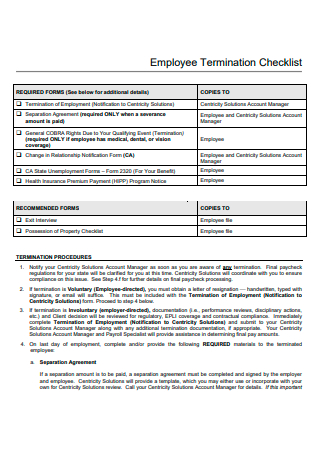
Employee Termination Checklist Template
download now -
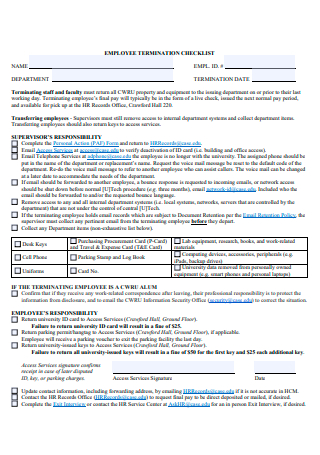
Formal Employee Termination Checklist
download now -
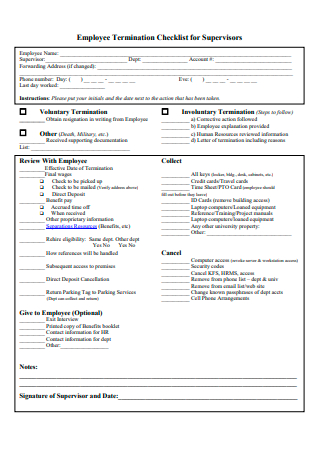
Supervisors Employee Termination Checklist
download now -
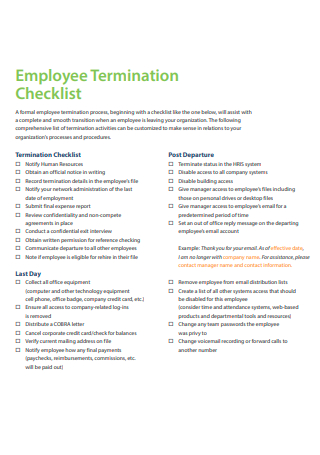
Employee Termination Checklist Example
download now -
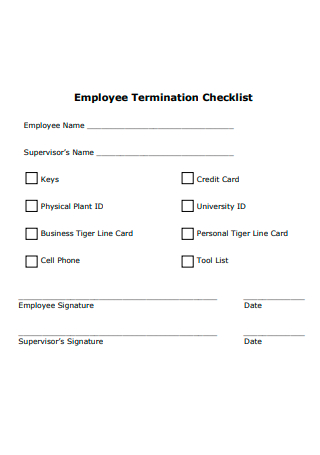
Basic Employee Termination Checklist
download now -

Standard Employee Termination Checklist
download now -
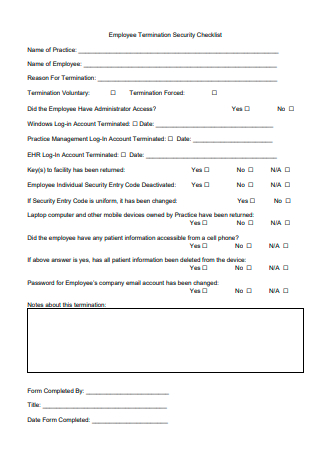
Employee Termination Security Checklist
download now -
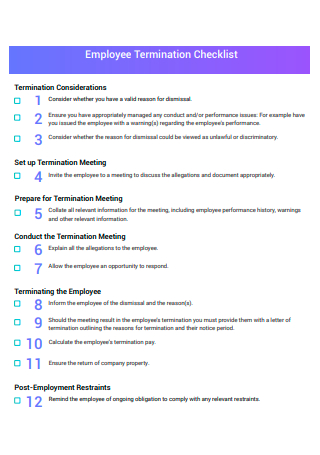
Employee Termination Checklist in PDF
download now -
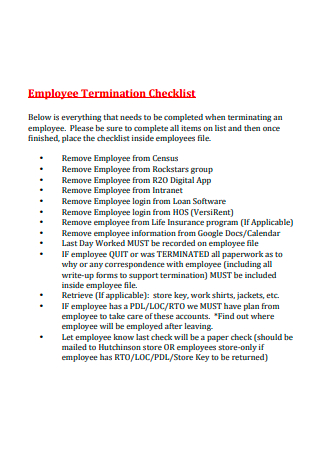
Simple Employee Termination Checklist
download now -
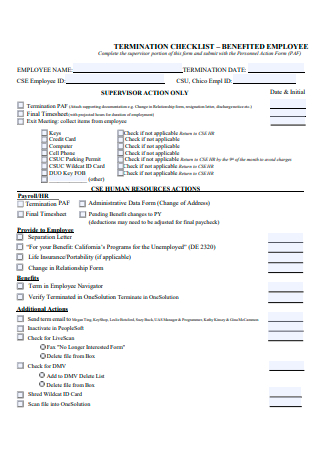
Benefited Employee Termination Checklist
download now -
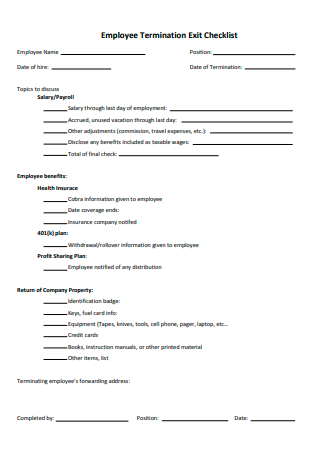
Employee Termination Exit Checklist
download now -
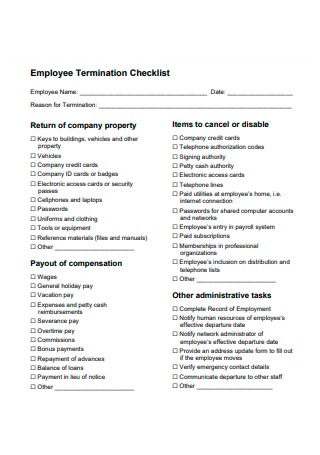
Sample Employee Termination Checklist
download now -
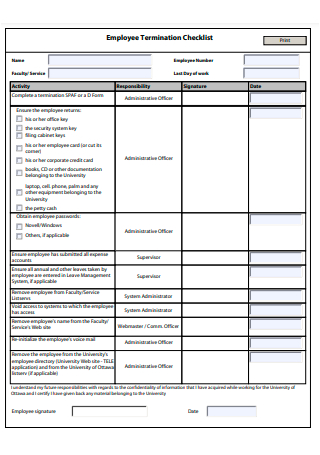
Employee Termination Checklist Format
download now -
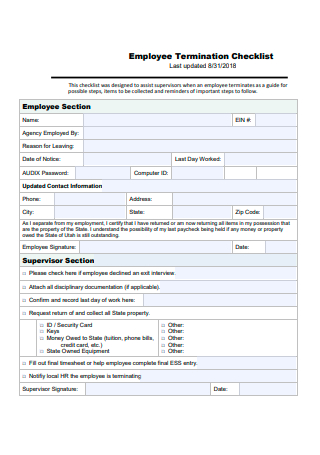
Printable Employee Termination Checklist
download now -
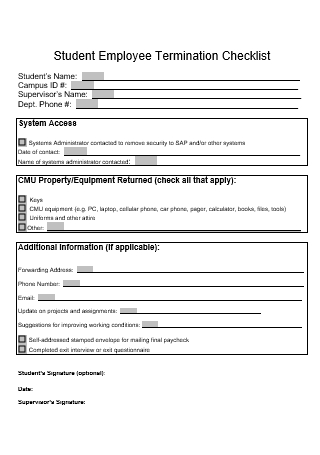
Student Employee Termination Checklist
download now
FREE Employee Termination Checklist s to Download
14+ Sample Employee Termination Checklist
What Is an Employee Termination Checklist?
Reasons an Employee May Be Terminated
How to Properly Terminate an Employee
How to Create an Employee Termination Checklist
FAQs
What documentation do I need to terminate an employee?
What is an employee exit checklist?
What are the rules for terminating an employee?
What Is an Employee Termination Checklist?
An employee termination checklist is a printed or electronic handout that human resource practitioners use to remind them of the requirements needed when an employee’s contract is terminated on whatever grounds or basis.
According to an online article by TechRepublic, the coronavirus pandemic has forced countless companies to make the tough but necessary decisions on the employment of their staff. The global health crisis has resulted in layoffs and furloughs, with millions of people and families suffering the economic impact of the pandemic. Just a little around a month after worldwide lockdowns were implemented, more than 26 million unemployment claims were made.
Reasons an Employee May Be Terminated
There can be several reasons why an individual’s employment contract is terminated. Usually, employees are given new hire orientations wherein the grounds for termination detailed and explained in the employee handbook. It is expected that the employee accepts these policies and thus is responsible for any conscious violation of the rules. The following examples are some of the most common reasons an employee ends up terminated in his or her respective workplace.
How to Properly Terminate an Employee
Talk to any human resource practitioner and they will tell you that firing another employee is one of the toughest things to do in their field. Despite the difficulty of breaking the bad news, there is an ideal way to cut ties and inform an employee that they are being let go. If you are tasked with this challenging job, keep the following tips in mind:
How to Create an Employee Termination Checklist
The process for employee termination is not as simple as merely signing a document. There are several steps and procedures that you, as an HR professional, need to take into account to facilitate a smoother termination and transition process. The quick step-by-step guide below will walk you through how to create your own employee termination checklist.
Step 1: Prepare the Basic Information
The first step is to cover all the employee’s basic data. Human resources should always have the complete file on the employee. Files that contain information such as application forms, medical records, performance reviews, memos or notices, and other relevant documents that concern the employee. You would need to prepare these ahead of time so you can easily locate and compile the necessary paperwork when the time comes. Even other basic information such as biometrics or computer passwords will need to be eventually deleted once the termination of the employee is finalized. For this, HR typically needs to coordinate with the IT department to wipe down any passwords and traces.
Step 2: Customize Your Checklist Format
Prepare a checklist so you can be certain you do not forget any important matter. Your checklist can be detailed or simple, it depends entirely on your preference. Choose a format that you are comfortable with. A checklist is fairly self-explanatory; you just need to make sure that your format is organized and the details are accurate. If you want a straightforward format, using basic bullet points or a simple table would work just fine. The downloadable samples above are useful reference guides that you can use if you are unable to decide on a format. And for ideas on what to put in your checklist, you may refer to the same templates above.
Step 3: Gather Important Documents
A key job in the finalization of employee termination is the preparation of important documents relating to the employee. If a resignation letter is applicable, make sure to obtain an original copy. The human resources department is tasked to furnish all the important documents pertaining to the finalization of separation. Clearance forms are one such example. Before an employee can officially sever ties with a company, he or she must be cleared of any pending transactions. For example, unliquidated receipts or incomplete reports must be attended to in order to prevent any further delays and inconvenience in their separation.
Step 4: Schedule the Dates
A critical part of your employee termination checklist are the important dates you need to take note of. Human resources will typically schedule an exit interview once the termination or resignation has been initiated. Setting a date to sit down with the employee is required. It allows the chance and space to clarify issues and other concerns, as well as gain insight and feedback from the outgoing employee. In addition, you may also need to set specific dates for the official turnover of office tasks, functions and other items. Company property or fixed assets such computer monitors and office equipment would need to be properly returned as well. Again, human resources is responsible for initiating and facilitating these processes in order to conduct a smooth termination and/or transition.
FAQs
What documentation do I need to terminate an employee?
According to an online article by the law firm enterprise Akerman, documentation is of utmost importance when it comes to the termination of an employee. Some of these main records that need to be diligently filed include performance reviews, biodata application forms, medical records, job offer letters, attendance records, and other relevant documents signed by the employee.
What is an employee exit checklist?
An employee exit checklist is a complete checklist that can help serve as a reminder for human resource professionals on how to properly conduct employee separation or termination. It lists all the essential items and tasks that need to be accomplished to facilitate a smooth and seamless sending off.
What are the rules for terminating an employee?
There are numerous guidelines to follow when it comes to terminating an employee. The most important rule is to ensure that the termination is in accordance with existing labor laws, and that the grounds for separation are valid and lawful. There must be reasonable or just cause whenever the employer intends to terminate the job contract of an employee.
It is never an easy task to terminate an employee. For HR professionals, it is one of the most challenging and uncomfortable parts of the job. But if the grounds for termination are reasonable and clear, then it is an inconvenient but necessary task. Before sitting down with the employee, make sure you come well prepared with a comprehensive employee termination checklist. Browse the selection of sample templates above and customize your own checklist today!
